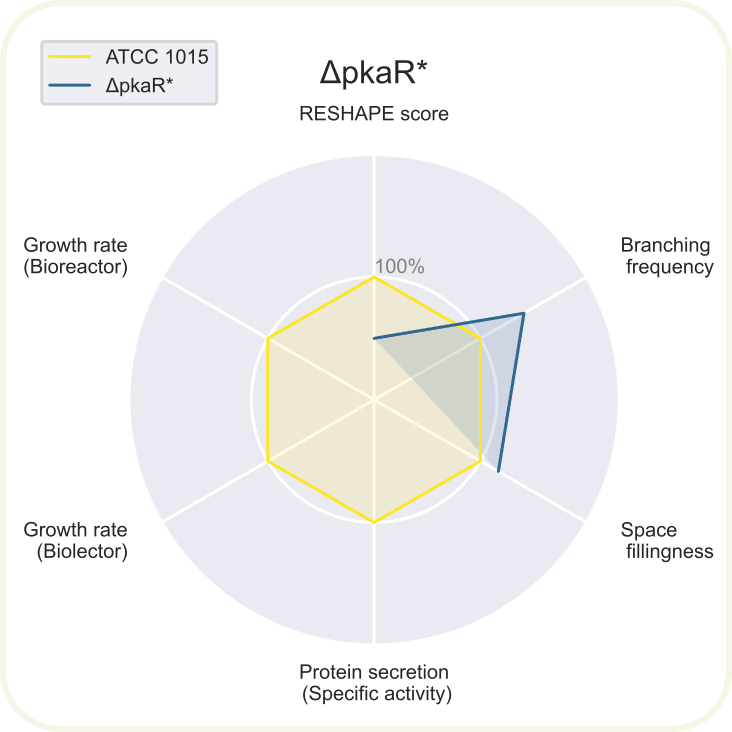Part:BBa_K3385038
CRISPR_pkaR_KO
Theoretical expectation: pkaR encodes a regulatory subunit in Protein Kinase A (PKA) which is involved in stress response and regulation of morphology and growth. The gene has been characterized in Neurospora crassa and a homolog was found in A. niger.
Full guide construct for knockout of the regulatory subunit (repressor) of the cAPM-dependent protein kinase gene (pkaR) in A. niger. This BioBlock has to be cloned into the PacI/Nt.BbvCI digested pFC330 backbone.

Functionality: The sgRNA efficiency has been accessed through the technique to assess protospacer efficiency (TAPE) [2]. A repair oligo is used to mediate homologous recombination, where a highly efficient sgRNA will show no colonies without the repair oligo, while less efficient sgRNA will show a reduced number of colonies.
Results: Below is a picture showing A. niger transformed with CRISPR_pkaR_KO and the repair oligo for pkaR. It shows efficient gene deletion when it's transformed with a repair oligo.

To see if the K/O’s were successful, other than looking at macromorphology, tissue PCRs were performed. By the amplification of specific primers, upstream and downstream of the gene, it can be verified if the gene has successfully been knocked out. If it has been knocked out the primers are gonna be closer to each other resulting in a smaller band in the Tissue PCR. However if the gene is still present in the genome, the band size will be the same as the target gene as seen in the table below.
| Targeted gene | Expected gene length after K/O | Control lenght |
|---|---|---|
| ΔchsC | 704 bp | 1867 bp |
| ΔpkaR | 370 bp | 1661 bp |

Summary: The strain shoed lower growth rate in the BioLector along with an increase in branching frequency. Protein secretion could not be studied as it was not run in the bioreactor due to time limitations.

Radar chart showing 6 different parameters of ΔpkaR normalized to the reference values from ATCC 1015 (shown in yellow). Read about the axis in the summary section on the result page.
*Indicates that not all data was obtained to fill out the chart.
Plates
The strain was grown on Yeast Extract Peptone Dextrose (YPD), Transformation Media (TM), Creatine Sucrose Agar (CREA) and Czepek Yeast Extract Agar (CYA).
Microscope pictures and Simulation model

Left: Confocal microscope picture of ΔpkaR at 10X magnification after app. 24h growth. Right: Growth simulation for 12h performed using the Mycemulator.
Microscopic images were analyzed by the image analysis tool extracting growth parameters which were then fed to the Mycemulator. A simulation of ΔpkaR growing for 12 hours (using the experimental growth rate from our BioLector data) is seen above.
Parameters specific for simulating ΔpkaR:
- Branching frequency: 0.0312627
- Gamma distribution parameters used for curvature angles: (1.6546373, 8.6411386)
- Beta distribution parameters used for branching angles: (1.4343473, 0.5666034)
- Experimental growth rate: 0.2090333
BioLector
Comparing the growth kinetics of the ΔpkaR mutant with the reference strain ATCC 1015 in the BioLector, the mutant exhibits a similar lag phase and a longer exponential growth phase. The growth rate for the mutant is lower than for the reference strain, at μMax0.21h-1 versus &muMax0.28h-1.
Growth profile of ΔpkaR over 72 hours, measuring absorbance at 620 nm. Plotted against the reference strain (ATCC 1015) shown in yellow.
Bioreactor and Protein secretion
ΔpkaR was not run in the bioreactor due to time limitations. Data for growth in bioreactor and protein secretion for this strain were therefore not obtained.Sequence and Features
- 10INCOMPATIBLE WITH RFC[10]Illegal EcoRI site found at 489
Illegal EcoRI site found at 660
Illegal EcoRI site found at 831
Illegal SpeI site found at 978 - 12INCOMPATIBLE WITH RFC[12]Illegal EcoRI site found at 489
Illegal EcoRI site found at 660
Illegal EcoRI site found at 831
Illegal NheI site found at 333
Illegal SpeI site found at 978 - 21INCOMPATIBLE WITH RFC[21]Illegal EcoRI site found at 489
Illegal EcoRI site found at 660
Illegal EcoRI site found at 831 - 23INCOMPATIBLE WITH RFC[23]Illegal EcoRI site found at 489
Illegal EcoRI site found at 660
Illegal EcoRI site found at 831
Illegal SpeI site found at 978 - 25INCOMPATIBLE WITH RFC[25]Illegal EcoRI site found at 489
Illegal EcoRI site found at 660
Illegal EcoRI site found at 831
Illegal SpeI site found at 978
Illegal AgeI site found at 204 - 1000INCOMPATIBLE WITH RFC[1000]Illegal BsaI.rc site found at 162
[1] A CRISPR-Cas9 System for Genetic Engineering of Filamentous Fungi. Nodvig CS, Nielsen JB, Kogle ME, Mortensen UH. PLoS One. 2015 Jul 15;10(7):e0133085. doi: 10.1371/journal.pone.0133085. eCollection 2015. PONE-D-15-11561 [pii] PubMed 26177455
[2] Efficient Oligo nucleotide mediated CRISPR-Cas9 Gene Editing in Aspergilli. Nodvig CS, Hoof JB, Kogle ME, Jarczynska ZD, Lehmbeck J, Klitgaard DK, Mortensen UH. Fungal Genet Biol. 2018 Jan 8. pii: S1087-1845(18)30004-5. doi: 10.1016/j.fgb.2018.01.004. 10.1016/j.fgb.2018.01.004 PubMed 29325827
